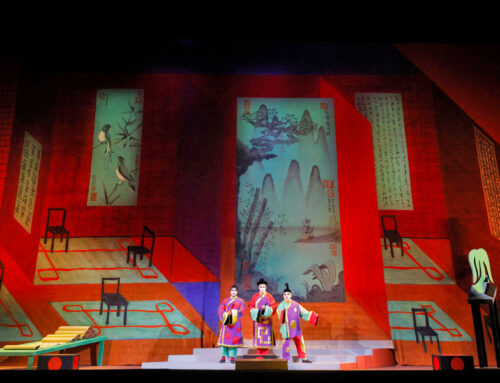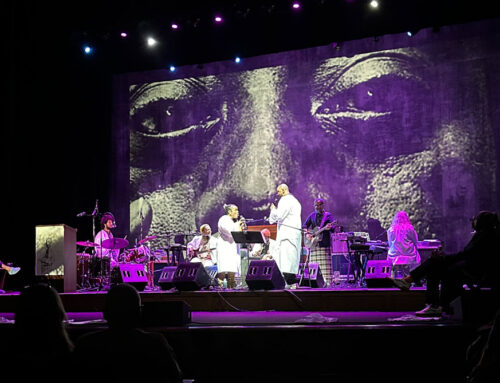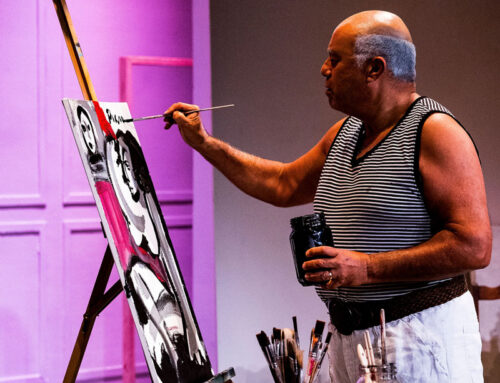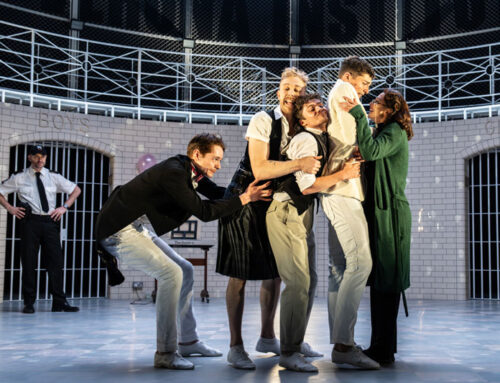The Joffrey Ballet presented a visually captivating cinematic production of its award-winning Anna Karenina at The Music Center.
The Joffrey Ballet Anna Karenina

Anna Karenina Victoria Jaiani Alberto Velazquez; Photo by Cheryl Mann
Choreographed by Ukrainian-born Yuri Possokhov, the narrative ballet transforms Tolstoy’s epic novel into two-acts of emotionally intense movement. The impeccable period costumes and striking sets designed by Tom Pye transports us into 19th-century Russia. In addition, Finn Ross designed the large scale film projections which enhanced the visually immersive experience that adds a dream-like quality. The lighting design by David Finn also creates an atmospheric and foreboding mood throughout Ilya Demutsky’s neo-romantic score. The performance of Scott Speck’s orchestra reinforces a haunting intensity as well as a sensitivity to the performance. Lindsay Metzger’s melancholy vocals adds another dimension to the story, though the lyrics and libretto are not published. The creativity of the production enables the audience to be deeply affected without needing to know the specific goings-on. The printed program describes the action in each scene and Possokhov offers his own notes on the production.
The Story of Anna Karenina
Anna Karenina is the story of a love triangle in addition to a woman’s tragic self-destruction. Anna has a passionless marriage, and a child, with her older husband Karenin, a politician. She meets and craves the love of Vronsky, a dashing young military officer. Setting a contrast is another young couple, the vivacious Kitty and the moral Levin who navigate a complicated courtship. The first line of Tolstoy’s novel suggests an underlying theme, “Happy families are all alike; every unhappy family is unhappy in its own way.”
The lead dancers changed for each of the four performances during this production. I saw Edison Barbosa (Karenin); Amanda Assuceno (Anna); Jose Pablo Castro Cueva (Vronsky); and Yumi Kanazawa (Kitty) and Xavier Nunez (Levin). Most notable was Assuceno’s emotionally expressive display of physicality in her solos and with the two men. Castro Cueva displayed a lightness and his pas de deus with Assuceno exuded their mutual passion, tension, and sexuality.

Anna Karenina, The Joffrey Ballet, Victoria Jaiani Alberto, Alberto Velazquez, Dylan Gutierrez; Photo by Cheryl Mann
Trains play a key role in providing a cinematic quality to the narrative. The initial scene is a winter tableau in the St. Petersburg train station with large scale projections of spinning train wheels. In the final scene stagehands costumed as railroad workers nailing down pieces of the railroad track. Tormented, Anna arches her back and spreads her arms as an oncoming train approaches and her projected shadow fades.
The Epilogue
Curiously, the Epilogue to the ballet, which I felt was long, shifts to the countryside. In this tranquil atmosphere Kitty and Levin enjoy their blissful marriage among frolicking folk threshing and rolling in piles of grain.
Supporting the narrative throughout are wonderful dancers portraying elegantly dressed ballroom couples, officious members of parliament, peasant couples, and others. Robert Joffrey and Gerald Arpino founded the Joffrey Ballet in 1956 by and it continues to thrive under Artistic Director Ashley Wheater MBE and President and CEO Greg Cameron.
Check out more about Glorya Kaufman Presents Dance at The Music Center – https://www.musiccenter.org/





![Review: The Rite of Spring & common ground[s] at the Music Center](https://www.laartparty.com/wp-content/uploads/2024/02/review-feb2024-music-ctr-common-ground-credit-maarten-vanden-abeele-web-800-500x383.jpg)
